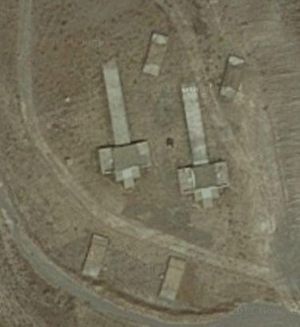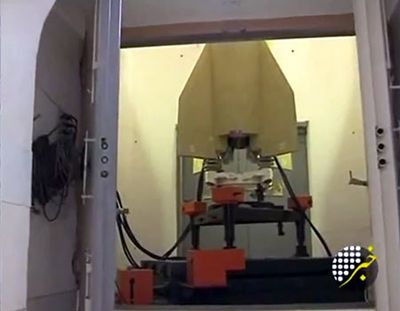
Out of sight but not out of mindby Dwayne A. Day
|
| An important tool that the United States has for detecting and assessing underground complexes is satellite reconnaissance. |
What prompted the sources to speak to the Post? And, considering how sensitive the information was, why hadn’t the Obama Administration requested—as they have on several occasions—that the Post not print the story? The obvious conclusion is that the administration probably initiated the story to send a message. But to whom? Perhaps the message is intended for Iran: “Don’t think that you can protect your nuclear facilities from attack. Negotiate a settlement or face the consequences.” Or perhaps the message was intended for Israeli officials about to visit Washington: “There is no ‘closing window of vulnerability’ during which you have to attack Iran before they can safely protect their nuclear facilities. They will be vulnerable for a long time.” Most probably, the message was meant for both countries.
But the story highlights the fact that the US intelligence community has long had an interest in determining the vulnerability of underground complexes. In fact, the Defense Intelligence Agency even has a dedicated organization for addressing them, the Underground Facilities Analysis Center, or UFAC. An important tool that the United States has for detecting and assessing underground complexes is satellite reconnaissance. But this is a limited resource because of the obvious fact that it’s hard to use photography from space to detect activities under ground.
William Burrows’ classic 1986 book about satellite reconnaissance, Deep Black, opened with a vivid scene of retired US Air Force Major General George Keegan recounting how in the early 1970s he had become obsessed with Soviet civil defense preparedness. As head of Air Force intelligence, Keegan had ordered his junior officers to gather all the satellite photography that they could of Soviet underground shelter building. Eventually he compiled a massive amount of data indicating—he claimed—that virtually every large apartment building erected in the Soviet Union since 1955 included a fallout shelter, factories had underground bunkers, and there were “seventy-five huge underground command posts.” A few of these underground facilities housed command centers for the Strategic Rocket Forces and were buried in the Ural Mountains. In particular, Yamantau Mountain (“Evil Mountain” in the local Bashkir language) and Kosvinsky Mountain were considered to be the Soviet equivalents to Cheyenne Mountain in Colorado, home to NORAD (not to mention the W.O.P.R. and the Stargate).
Today several non-governmental organizations use commercial remote sensing images to detect underground facilities in places like Iraq and North Korea. Some of their work is very impressive, but the US intelligence community is undoubtedly much better at this. They certainly have more powerful satellites and software.
| Iran is apparently relatively new to the concept of burying things, and probably not very good at it yet. |
Satellites can spot the beginning of tunneling activity, but it is often nearly impossible to determine where a tunnel goes beyond its entrance: right, left, up, or down? In some cases it has been possible to track the amount of material being removed from tunneling activities, but one former intelligence analyst has said that he was mystified by how little evidence satellite reconnaissance revealed of the material removed during Soviet tunneling activities. He couldn’t figure out where they were dumping all the rocks.
 Iranian underground missile silo. |
Satellites can search for entrances, air vents, or other signs of vulnerability. Although it might be impossible to completely destroy an underground complex, bombing the entrances and air vents, and sending seismic shocks into the complex’s support infrastructure like water and power supplies, may be sufficient to render it unusable. Or maybe not. During the Cold War, the former intelligence analyst said that lack of information about Soviet leadership compounds at Chekhov and Sharapovo led the Air Force to plan for using many of its W/B-53 9-megaton warheads—the largest in the American arsenal—to plaster the entire area in the hopes of destroying it.
The US intelligence community’s interest in underground facilities lasted beyond the end of the Cold War. It was accentuated during the 1991 Persian Gulf War when Desert Storm military forces sought to destroy Saddam Hussein’s underground facilities—and by the fact that following that military action, several other countries, including Libya, North Korea, and China, invested heavily in underground complexes. A primary source of intelligence—very good intelligence, apparently—has come when foreign construction crews are hired to build the facilities. They are later debriefed by Western intelligence agencies. Sometimes they provide blueprints.
 Iranian underground missile silo. |
Iran is apparently relatively new to the concept of burying things, and probably not very good at it yet. In summer 2011 Iran revealed that it had developed underground missile silos, although apparently the silos had been visible in commercial satellite photography since at least 2008.
In 1993, the CIA held a conference on underground facilities, and undoubtedly has held numerous ones since then. One person who attended that conference recounted a rather sobering anecdote, however. Apparently the end of the Cold War resulted in many Russians emigrating to the West and offering up their knowledge, including some who had worked in the Kosvinsky Mountain complex, which was built under a granite mountain. At the conference, an Air Force general remarked that his service had reluctantly concluded that they could nuke Kosvinsky all day long and still not be sure that they had destroyed the Russian nuclear command post. Granite is tough.
Who knows? Maybe the Iranians are short of granite.